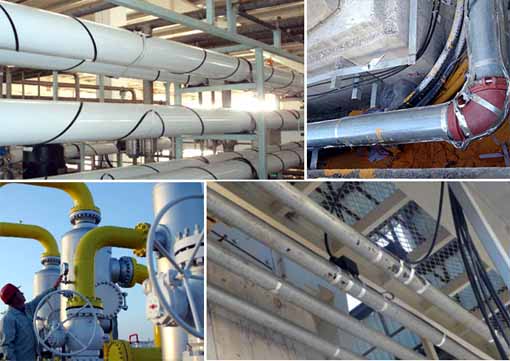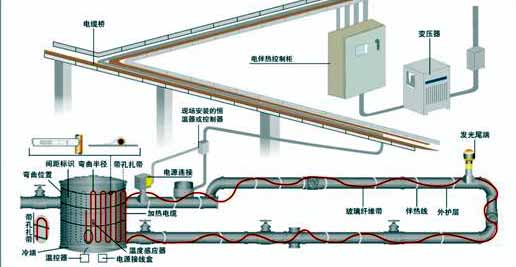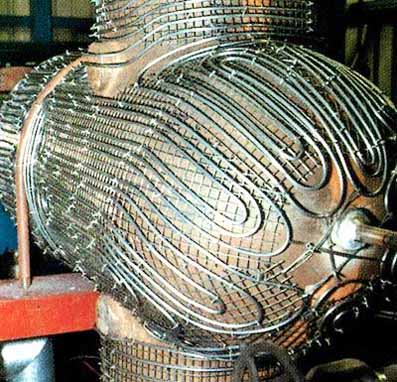Electric Heating Cable Failure and Maintenance
Electric heating cable repair procedures
The pipeline temperature of the electric heating cable is uniform, neither too hot nor too cold, so it is very safe and reliable. Electric heating cables can save electricity to a great extent. However, safety inspections are very important during use.Routine inspections should be carried out on the pipeline constant temperature system before use. If the electric heating cable belt, accessories, insulation layer or waterproof layer is found to be damaged, it should be replaced and repaired immediately. The meter test can generally be performed at the end of the cable, and all repair details are recorded on the repair record sheet.

Failure Analysis Table
Failure signs, possible causes, correction methods
Circuit breaker trip:
1. Low temperature power transmission trip of heating system
2. Line short circuit trip
3. The contact or the middle of the heating belt is burned out and tripped
4. After the circuit is tripped, a combustion accident occurs during forced power transmission
1) The circuit breaker selection is too small, and the heating belt is used over long, causing overload tripping. The maximum use length of the cable is restricted by the size of the conductor core section of the product, the nominal power, the level of the ambient temperature when starting or the temperature level of the heating system.
2) ① The two wires at the tail end are twisted to produce a short circuit,
② The insulation of the contact is not good or the intermediate insulating layer is damaged due to installation. If it is normal when it is used for the first time and a short circuit occurs midway, it is generally caused by the following reasons:
A. The insulating layer at the end and the end shrinks, exposing the conductive part
B. Use absorbent insulating tape
C. There are hidden dangers of damage to the insulation layer of the product, such as: rigid (iron wire) binding, electric drill drilling, etc., or the insulation layer at the contact point is not waterproof during installation. The above situations can often be installed incorrectly, so when a, b, c and other conditions are in a wet state, there will be a short circuit.
3) The circuit is not equipped with leakage protection, the function control device of overcurrent protection or the protection is available, but it fails successively or the electric heating cable has no grounding shield or is not grounded to form a control loop. When the above 1.2 situation occurs, a burn-out accident occurs after multiple power transmissions after tripping, and the final result is that the heating cable is burned.
4) Wrong selection of electric heating cable:
① Choose an unshielded heating cable.
② If no special product is selected, if the product is immersed in cold water and the parameters are selected according to the conventional design, it may happen that the two-way protection is out of control and burns when the overload occurs.
1) Perform preliminary thermal or electrical design according to the design document, and install or correct the cause of the accident according to the installation book or precautions;
2) Any circuit must be equipped with leakage protection and overcurrent protection.
3) The product must be shielded or shielded reinforced, and the product and the controller should form a good control loop.
4) Unshielded products should be semi-finished products and need to be equipped with additional safety measures. Otherwise, there are potential safety hazards and use in violation of regulations.
5) After the circuit is tripped, the explosion-proof area can not be forced to send power again, even if there is overcurrent protection, it is easy to cause vicious accidents such as burning when the hidden danger or the cause is unknown.
6) It is recommended to choose special patented products in explosion-proof areas, and the products are completely non-combustible materials.

System heat generation is zero or low
1) The voltage of the power supply is zero or low;
2) Some accessories are not connected or the heating cable is cut off;
3) There are improper connections in some accessories;
4) The thermostat is erroneously adjusted to the closed state;
5) The heating tape has been damaged when the pipeline is in a high temperature state;
6) The heating tape has been damaged after being exposed to too high temperature;
A. Replace the damp insulation layer with a dry one, and add a waterproof cover;
B. Use two to make up for the lack of heating cables, but the total line length cannot exceed the limit;
C, re-adjust the thermostat controller;
D. Recheck the design parameters and make necessary adjustments;
The system heats up normally, but the pipe temperature is lower than the design value
1) The insulation layer is damp;
2) Insufficient amount of heating cable or improper selection;
3) The thermostat controller is not adjusted correctly;
4) The parameters used in the calculation of heat loss are inconsistent;
A. Replace the damp insulation layer with a dry one, and add a waterproof cover;
B. Use two links to make up the missing electric heating belt, but the total line length cannot exceed the limit;
C, re-adjust the thermostat controller;
D. Recheck the design parameters and make necessary adjustments;
Electric heating cable is not hot or uneven
1) Exceeding the use period, this situation generally weakens gradually;
A, no heat preservation
B, the insulation layer is too thin or uneven
C. The insulation layer is not waterproofed, and the insulation layer is immersed in rain and snow, so that the electric heating cable part will be in a low temperature or humid state for a long time and work with a larger output power. One does not save energy, and the attenuation rate is uneven;
3) Poor quality of heating tape
1) Choose electric heating cables from various manufacturers that are marked with nameplates, various technical indicators and manufacturing dates;
2) Install in strict accordance with the requirements of the product instructions;
3) A waterproof layer should be made along the entire line of the insulation layer to make the electric heating belt work in a dry state;
4) Choose special patented products and look for brands.

There is a big gap between the initial use effect and the design effect of the electric heating cable
1) The product selection is wrong or the technical parameter selection is low.
Technical indicators of electric heating cable:
1. Standard color: red
2. Temperature range: the maximum working temperature is 130±5℃;
The maximum exposure temperature is 150℃; Maximum withstand temperature: modified polyolefin 105℃, flame retardant polyolefin 105℃, fluorine-containing polyolefin 180℃, perfluorinated material 205℃
3. Construction temperature: minimum -40℃
4. Thermal stability: After cycling back and forth 300 times from 10℃ to 149℃, the heating value of the cable is maintained above 90%.
5. Bending radius: 38.5mm at -20℃; 49.0mm at -30℃
6. Insulation resistance: The cable length is 100m, when the temperature is 75℃, the minimum insulation resistance is 20MΩ, shielded or explosion-proof type. When the room temperature is 20℃, test between the shielding layer and the conductive core with 2,500VDC for 1 minute, and the minimum insulation resistance is 1200MΩ.





